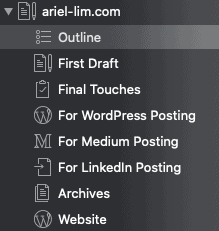Have you ever worked with a client (or worked for someone) who doesn’t value what you bring to the table?
Most of the time, these people give great lip service in trying to sell the work/company, but when you get onboard, that’s when all hell breaks loose.
I did.
Background
As what some of you might know, I got fired from my last corporate job. The BS reason my boss gave to me is that I “didn’t meet management’s targets.” But the reason behind it, I’ll leave that up to you.
But here’s a fact: The results I brought in during my short time there exceeded the results of the previous 3 people in that same role for the same metrics.
I can’t quite remember the exact numbers now, but when I did the math before, the KPIs were 4x than the combined results of the last 3 people who were in that role.
I stayed in the role for ~3 months. The last 3 people who were in that previous role had it cumulatively for around 1.5 years.
But I digress.
History Repeats Itself
A few years after, I found myself in a similar situation.
I had a client who doesn’t seem to know how to look in the mirror.
Everything bad that happens is somehow always because of the people around my client, i.e. other consultants/contractors.
It was never my client’s fault.
This client never listens. Don’t know how to answer.
Shuts you down when you raise concerns. Answers a simple yes-no question with a 25 minute story, that by the end of it, you either don’t want to ask anymore or simply just forgot what the original question was all about.
At this point, you already know that this is a bad client.
There are lots of red flags.
But I’ve got bills to pay.
Red Flags to Watch Out For
No Respect for Other People’s Time
This client wants you to stick to a budgeted number of hours (i.e. 10 hours), but wants you on team meetings every single day.
Each meeting lasts 5 hours.
During each team meeting that happens over Skype, you share your screen as the client tells you what to do while everyone watches.
Imagine that scenario.
You’re on a screen-share call with 5 other people. Your desktop is open for everyone to see. The client asks you to open this file. Edit this sentence. Adjust the font. Etc.
What if you’re one of the other people on the call?
Is that something you need to “see” step-by-step? Is that something you’d enjoy being part of?
Doesn’t Value You as a Person
During this meeting, the client just talks and talks and talks about everything EXCEPT the tasks that you need do.
Only the person who’s sharing the screen gets to do any sort of work during this meeting.
After some time, maybe around 45 minutes, the conversation shifts to updates on this other project.
Since there were no discussions on who does what by when, you’d have to ask how to move things forward.
But, when you ask to clarify the tasks, the client says, “I don’t have the time to answer all your questions. You ask too many questions. Just do this and let’s get on another call tomorrow.”
Waste of Everyone’s Time
It’s no wonder that a single webinar presentation has taken 4 months (and counting) to launch. Everyone gets on a Skype call, the client goes through slide 1, tells a 15-minute story, then goes back to slide 1 to decide on a title.
Then instead of going to slide 2, skips over to slide 53 because something came to mind.
Then, during that 20-minute soliloquy, the client wants to look up something on Google, so the client instructs the person sharing the screen to Google “lorem ipsum.”
The client then proceeds to share more stories about this image. 85 minutes in the call, we go back to slide 2.
Take note that the client insists on everyone to be on the call.
So that’s 5-6 people just watching the screen.
Oh, and since I was on a different time zone, here’s my schedule.
I wake up at 2am each day because that’s the time the client works.
Then, you’d find out that a meeting that’s supposed to be at 3am won’t take place until 7am.
No advanced warnings.
Just my client’s whims.
This client doesn’t respect us (employees and contractors) and everything we bring to the table. This client doesn’t respect our time.
So, for my sanity’s sake.
I fired my client.
How to Fire Your Client and Stop Working for People Who Doesn’t Respect You
Firing your client is never easy, especially if you really need the money.
But if you want to avoid these kinds of clients, be prepared to do the more work upfront.
Here’s what I learned over the years and something I am currently doing so I avoid getting in this situation again.
1. Have 6 months of cash in your bank
This isn’t usually discussed in the consulting/freelancing world, but it’s of grave importance.
If you want to avoid getting clients who aren’t a right fit for you but is willing to pay you something, you better have some sort of backup plan.
In this case, it’s this 6-month’s worth of cash.
Yes, cash.
Not the extra space in your credit cards.
Begin by listing down your essentials.
Those bills that need to be paid monthly. Not your nice-to-have’s. Not your lifestyle needs.
These are the fixed expenses that you can’t get out of in the short-run.
- Phone, internet, utilities
- Food or grocery budget
- Rent
Then think of ways to cut back on some expenses.
For example, instead of buying a Starbucks drink every morning, you can just buy a bag of beans and brew your coffee yourself. For the price of 3 Frappuccinos, you can get yourself a whole bag that can last you a week or two.
Once you have this list, multiply that by six.
Don’t forget to account for annual expenses. For example, in my case, that’s my web hosting and domain name registrations.
That’s your target to have in your bank account as cash.
Not credit. Cash.
That way, when times get rough, you can just dip into this while searching for the right client, instead of compromising.
2. Invest in yourself
One thing I recently applied to my life is that anything that involves my health or continuing education, I just go for it.
I don’t go crazy here. But it’s really very strategic if you think about it.
If you’re a programmer, the more you learn about programming, the trends or new techniques or approach, etc., the better your services will be.
If you’re a consultant like me, I stay on top of trends and do in-depth trainings on certain software or tools.
When it comes to health, you don’t have sick leaves. When you’re sick and don’t work, you don’t get paid.
So, what do you do?
Exercise. Drink vitamins. Eat healthy.
Don’t skimp out on this because you’ll suffer in the long run.
I’ve always had a back problem.
And in the last 2 years, it has moved up my neck/shoulders.
I invested in memory pillows and computer stands and back support. I’m now saving up for a better bed that can support my back.
All these are investments in myself because if I am not healthy, if I don’t get a good night’s rest, if I don’t wake up feeling refreshed, my work suffers.
And so does my income.
3. List down your client deal-breakers
Here comes the fun part.
If you’ve been consulting/freelancing for a while, you’ve certainly had your share of great clients and bad clients.
For this purpose, list down what you hated about your worst clients. They go into your deal-breaker lists. That way, when you speak with a potential client and it triggers a couple of these items in your list, you know you have to be extra vigilant.
Of course, that doesn’t mean if they do those things in your deal-breakers you shouldn’t take them as a client.
In most cases, yes, you shouldn’t.
Start thinking about what makes you hated working with them.
- Do they always pay late?
- Do they haggle your price?
- Do they implement your recommendations?
- Do they respect your time?
- Do they come to meetings prepared?
Once you have this list, you use it as a reference when you speak with a potential client. Then, depending on some other subjective factors, you can decide if you want to pursue this or not.
One thing to remember: when you talk about doing business with a potential client, you are in no means obliged to take them on.
Even after sending in your proposal.
It’s like a job interview. As an applicant, you still have the final to whether or not you want to work at that company. Don’t think that if you go to the interview, you have no choice but to work there.
Remember, you need to get a job offer first.
And even if you do, you can decide not to accept it.
Last February, before the world came to a stop, I applied this principle. Even after spending time getting to know a potential client’s business, researching and crafting a proposal, the potential client went on and triggered a bunch of things on my deal breakers list.
In the end, I didn’t pursue the relationship.
The reason is I followed the same advice I shared above.
- I saved up enough money for the next few month’s expenses.
- I have current clients who value my time and what I bring to the table
In short, I wasn’t desperate.
Which brings us to the next step…
4. Follow-through your plan
If you’ve done your deal-breaker list, you can proceed with listing traits of your best clients.
But the hardest is sticking with this plan.
If you followed my first recommendation, then you shouldn’t have to worry about this. The problem is that most consultants/freelancers live in cycles.
Good times and bad times.
This is because they don’t have a strategy in place to keep their funnel filled with opportunities (point number 5 below).
This is probably the biggest reason why consultants/freelancers (me included) take on clients even if we know that they’ll turn out to be a problematic client.
They triggered every item in your deal-breaker list, yet you still take them because they are wiling to pay and we need the money.
My recommendation is put up with it until you get to save up for your 6 months cash.
I did this for the next 8 months after firing this client (this was back in 2018). So, only until mid-2019 did I have enough cash in my bank to follow through.
Looking back, all I can say is that it’s worth it.
5. Keep your top-of-funnel filled
As consultants/freelancers, we often don’t take time to step back and look at how our industry work.
At the beginning, we don’t have any money.
So, this forces us to reach out, network, and do some “business development.”
Once we get a client and cash starts coming in, we shift focus to the current projects. After the project finishes, we go back to having no money, so we start prospecting again.
If you really want to get out of this vicious cycle, you don’t stop prospecting. Allot time to do it every week.
Or an even better solution is you automate this stuff for you.
Depending on your industry, this differs.
But I suggest listing down your activities on how you get prospects and leads, then think of ways to automate that.
For example, in my case, I do cold emails and inbound marketing.
For my cold emails, I use a CRM that has all my responses and follow-ups. After finding the right person to send to, I enroll them in that sequence. If they don’t reply, the followup email get sent.
If they reply, the sequence stops. This is usually where one-to-one conversation happens.
For inbound marketing, I continuously publish articles here.
Now, I’ve created a workflow for myself to distribute this content even further. After publishing on my website, I publish on Medium a week after, then on LinkedIn the week after that.
Then, my email marketing software automatically sends an email blast to my subscribers depending on the frequency they choose.
I have multiple lead capture forms all over my site.
Once in, they get enrolled in certain lead nurturing sequences. That way, I don’t think about “selling” to them manually. Everything is done automatically.
I then improve and update the sequences after every quarter. This makes sure I only use relevant content in my emails.
6. Deliver results, get out quick
Sometimes, even after all the screening, we still end up with a bad client.
What do you do in this case?
Get the smallest possible win or positive outcome then get out quick.
As much as I’d like to say this is what I did, it’s not exactly what happened with the client I was talking about.
Because the client disappeared for a few months, that was my way out.
After continuous followups for more than a month, there were no replies and/or decisions on proceeding with the next step.
What about you? Do you have a client (or a boss) that you’d like to fire or get out of? Did this happen to you before?
Let me know in the comments below.




